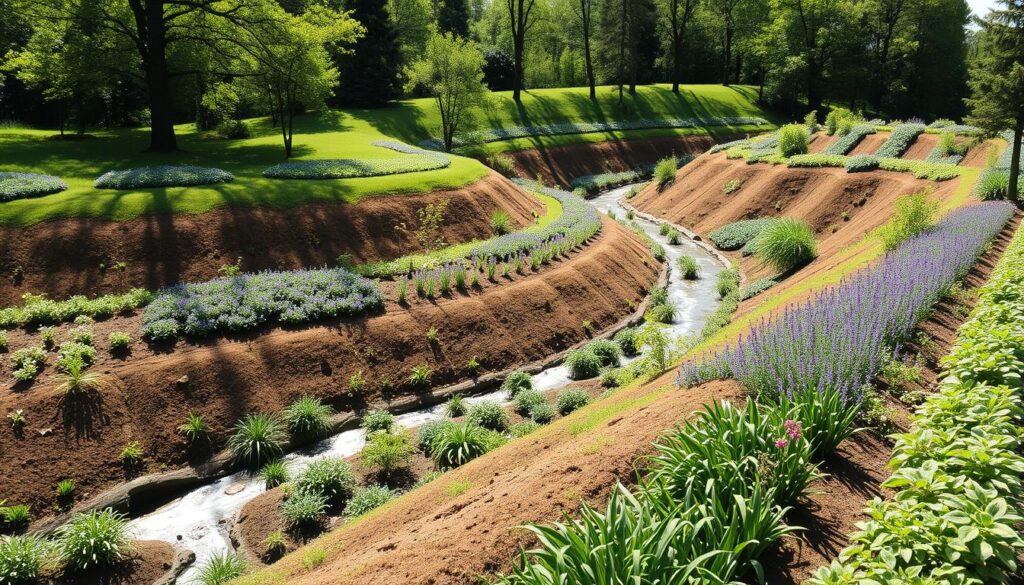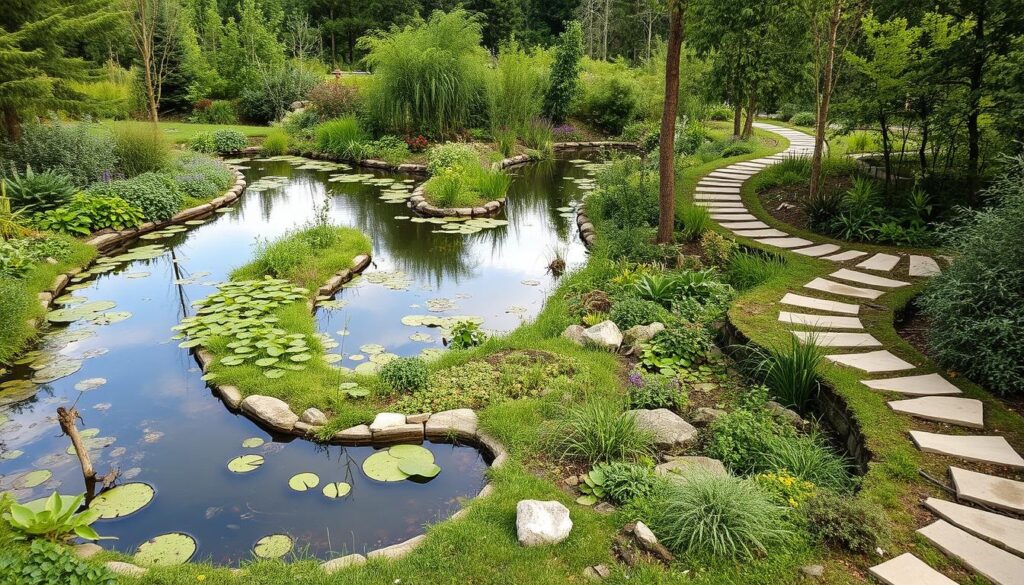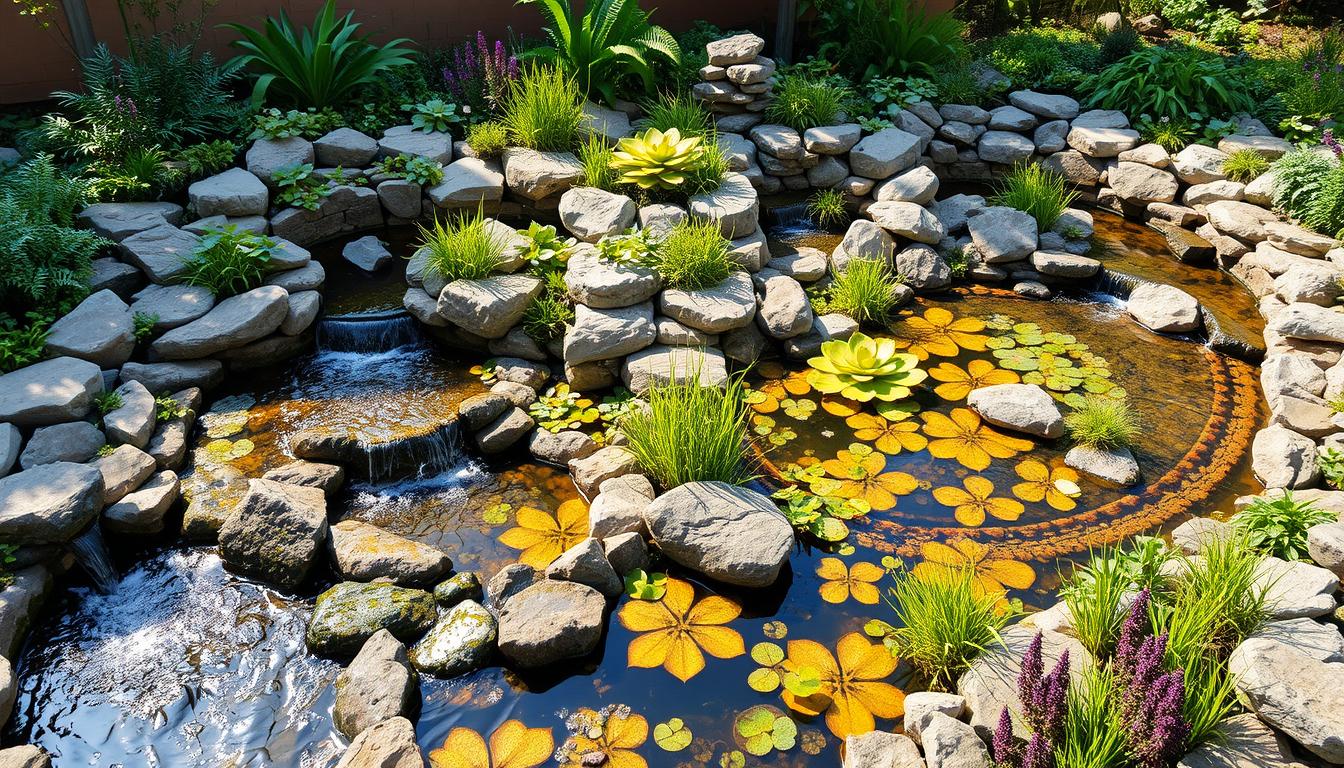As I step into my lush, vibrant garden, the soft gurgle of a nearby stream instantly captivates my senses. The gently undulating curves of the landscape seamlessly integrate with thoughtfully placed water features, creating a harmonious symphony of life. This is the essence of permaculture design – where aesthetics and function converge to nurture both the soul and the land.
In a world where water scarcity and environmental degradation threaten our very existence, the need to design sustainable, water-wise landscapes has never been more pressing. Permaculture offers a holistic approach to this challenge, empowering us to create gardens that not only quench our thirst but also nourish our spirits. By thoughtfully incorporating water features, we can transform our outdoor spaces into oases of beauty and ecological resilience.
Key Takeaways
- Permaculture design blends aesthetics and function to create sustainable, water-wise gardens.
- Thoughtfully placed water features can transform outdoor spaces into oases of beauty and ecological resilience.
- Designing permaculture water features requires consideration of factors like rainwater harvesting, swales, ponds, aquaculture, and water conservation techniques.
- Keyline design and other integrated water management strategies can optimize the flow and storage of water in the landscape.
- Maintaining the visual appeal of permaculture gardens, through elements like well-laid mulch and natural geometric patterns, is crucial for homeowners and community developments.
The Significance of Aesthetics in Permaculture Gardens
Permaculture focuses on function, but beauty matters too. Gardens that look good encourage us to spend more time there. This leads to better care and understanding of the garden.
The author compares this to weightlifting. Getting fit was a bonus, not the main goal. They think permaculture gardens should be beautiful, without losing their purpose.
Permaculture Gardens Can Be Beautiful
The author thinks permaculture designs can be stunning. They show how curved contours, well-mulched beds, ponds, and natural geometries make gardens beautiful. The aim is to find a balance between beauty and usefulness.
“Permaculture is a design system that mimics nature, focusing on aesthetics, functionality, productivity, and sustainability.”
Permaculture can be an art form in homes and yards. It creates food and resources. Designers need to match their skills with what clients want.
Design Elements That Bridge Form and Function
Permaculture design aims to blend beauty and usefulness in outdoor spaces. It uses elements like contour planting and mulch to achieve this. These features make spaces look good and work well.
The Silky Curve of Contour
Contour planting and swales are key in permaculture. They help slow and spread water and add beauty to gardens. Unlike straight lines in regular farms, these curves are more attractive.
The Tidiness of Well-Laid Mulch
Well-laid mulch is another important element. It’s good for building soil and saving water. The author also makes sure it looks neat, keeping it off paths.

Invoking the Spirit of Place with Water Features
The author thinks water features are key to bringing the “spirit of place” to life in a permaculture garden. They say water, like ponds or swales, links a landscape to its culture and history. These features also make a garden feel like a sanctuary.
Adding water to a permaculture design changes the garden’s look and feel. Features like ponds and streams attract wildlife and plants. They make the garden’s ecosystem thrive.
The significance of water features in gardens has been associated with healing properties and has historical roots in ancient practices across various cultures.
Designing water features with cultural wisdom makes them timeless. Ancient traditions, like using stones in pools, show the spiritual value of water. These practices have been passed down for centuries, highlighting water‘s healing power.
Using patterns from history in water feature design adds spiritual depth. The materials used reflect the local culture and heritage. This approach creates water features that are both functional and deeply connected to the land.
Sacred Pools and Holy Wells: Ancient Archetypes
Ancient cultures often decorated important water sources like natural pools and wellsprings with stones. These designs show a deep respect for water’s life-giving power. The author believes these designs are key for modern permaculture water features.
Patterns of Stone-Lined Pools and Wellsprings
Many cultures have decorated their vital water sources with stones. These sacred pools and holy wells were more than just water sources. They were spiritual centers for rituals and gatherings. The author sees these designs as lessons for today’s permaculture, inspiring water features that respect water’s value.

“The simple, yet profound, designs of stone-lined pools and wellsprings reflect a deep reverence for the life-giving power of water. They serve as important archetypes that can inform the creation of modern, ecologically-minded water features.”
By using these ancient patterns, permaculture designers can create water features that are both functional and sacred. This approach can deepen our appreciation for water’s role in life. It also encourages a more spiritual and holistic approach to landscape design.
Designing with Patterns: From Culture to Intuition
The author starts by connecting with cultural wisdom and intuition about water features. They avoid overly-engineered designs that feel artificial. Instead, they aim to create water features that feel natural and fit well with the local culture.
Nature is full of patterns, from atoms to galaxies. Humans have always used these patterns in their designs, known as biomimicry. The author uses this approach to create designs that blend with the environment.

Patterns greatly influence our behavior, from cells to societies. But, they can also lead to rigidity. By understanding these patterns, the author designs water features that feel right at home and adapt to their surroundings.
permaculture water features
Creating permaculture water features is all about mixing beauty with usefulness. The author uses special design elements to make features that look good and work well. They add curved lines, neat mulch, and natural shapes to make water features that are pleasing to the eye and useful too.
These features slow down water, help it spread, build soil, and offer homes to many animals. The aim is to find a perfect balance between how they look and what they do. This way, the beauty of the feature doesn’t get in the way of its usefulness.
Designing for Aesthetics and Function
The author mixes curved contours, tidy mulch, and natural geometries to make stunning and practical water features. These elements make the features look smooth and balanced. They also help with slowing water, building soil, and giving homes to many animals.
“Designing permaculture water features that seamlessly integrate aesthetics and function is crucial for creating a truly sustainable and harmonious landscape.”
This approach makes water features that not only make the garden look better but also help it stay healthy and strong. The end result is a beautiful and functional landscape that shows how beauty and usefulness can work together.

Mainframe Design: Water, Access, and Structures
The author talks about “mainframe design” in permaculture. It focuses on water, access, and structures. For water, the strategy is “slow, spread, and sink”. This method slows water down, spreads it, and sinks it into the soil.
This makes water features in the garden more efficient and useful.
Water: Slow, Spread, and Sink
Water is key in permaculture mainframe design. The “slow, spread, and sink” principle is vital for water management. It slows water down, spreads it, and sinks it into the soil.
This approach helps recharge groundwater and makes the garden more resilient.

The farm’s terrain has slopes from 1:3 to 1:1. The middle part is semi-flat, with slopes from 1:8 to 1:3. The farm’s altitude ranges from 1150 to 1250 meters, with a 450-meter distance between the highest and lowest points.
The initial map used 10-meter contour lines to show key points and water flow during heavy rains.
The farm has earthworks like a mud pond (A), small key point dam (B), and big key point dam (C). These manage runoff water well. In wet years, excess water goes sideways through a big swale (D) to a valley in the middle, hydrating the ground.
The Importance of Water in Permaculture Landscapes
In permaculture, water is key to keeping the ecosystem balanced. It’s the lifeblood that supports all life. Knowing how to capture, store, and distribute water is essential for a thriving landscape.
Managing water well is crucial in permaculture design. It’s important to understand rainfall, water sources, and the site’s watershed. This helps create a balanced water system.
Permaculture practices help soils hold more water. This reduces flooding and erosion risks. Techniques like keyline plowing and swales manage water flow. Choosing drought-tolerant plants and agroforestry also help.
“Properly managing water is often the primary limiting factor in a permaculture system.”
As water scarcity grows, permaculture’s role becomes more vital. It helps create landscapes that can survive with less water. This is especially important with climate changes.

Designing for Access and Connectivity
In permaculture design, access and connectivity are key. They work together with water management. Designers plan roads, paths, and gateways to make the site more functional and connected.
They align access routes with natural contours and water flows. This creates efficient systems that reduce erosion and make movement easy.
Efficient Access Through Thoughtful Planning
Designers watch how people move in a permaculture system. They place elements to make access better, reduce disruptions, and increase efficiency. They also plan for different ways to move, like walking and biking.
This helps cut down on fossil fuel use and lowers carbon emissions. By linking access with zones and elements, designers make movement and interaction better. This boosts productivity and saves energy.
Water management is also important in this design. Designers study water sources and how it moves. They work to make water use more efficient and sustainable.
They also make sure paths, entrances, and security are clear. This keeps the site safe from accidents and unauthorized entry.

Access and connectivity are part of the bigger picture in permaculture design. They work with zoning and systems analysis to create a whole, harmonious landscape. This makes the permaculture site a thriving, connected ecosystem.
Optimizing Structure Placement
The final step in permaculture design is placing structures like buildings and greenhouses. They should be near water and access routes for efficiency. This makes the landscape look good and work well.
When planning, think about the land’s shape, water flow, and how easy it is to get around. This way, structures won’t mess up the natural flow. For example, a greenhouse by water makes watering easier. A tool shed near the path helps keep gardening tools handy.
Adding structures to the landscape can make it look better too. By matching the built parts with nature, you get a beautiful space. This is done by smart placement, using natural materials, and adding landscaping that fits the area.
So, placing structures wisely is key in permaculture design. It makes the landscape work better and look great. This creates a complete and green system.
Creating Natural Swimming Pools and Ponds
Integrating natural water features is key in permaculture landscapes. The author talks about making natural swimming pools and ponds. These features are beautiful and support many aquatic life forms. They aim to blend beauty with ecological function, fitting well into the permaculture system.
Balancing Aesthetics with Ecological Function
Natural swimming pools and ponds work like natural ecosystems. They use clay lining or the “gleying” technique to stay balanced. These water features are great for swimming and can also water gardens or orchards when it’s dry.
The author stresses the need to think about where and how big these water features should be. For example, a clay-lined pond needs a gentle slope and should be at least eight meters across. The planted area should be at least 50% of the pool’s size, balancing the swim area with ecological needs.
By designing these natural water features, the author shows how permaculture can create beautiful and eco-friendly landscapes. These landscapes offer many benefits, like places to swim and help manage water sustainably.
Rainwater Harvesting and Greywater Systems
The article talks about designing rainwater harvesting and greywater systems in permaculture. These strategies help make the system more efficient and self-sufficient. The author shows how to combine these with swales and aquaculture for a closed-loop water cycle.
Rainwater is abundant and can be collected and used around homes. It reduces the need for pipe water and lowers mains water demand. Using rainwater helps people live more sustainably and be more resilient.
It’s important to filter rainwater to keep it clean and pure. Rainwater is great for flushing toilets with just a basic filter. It’s also perfect for gardening, providing plants with nutrient-rich water.
Building swales can store a lot of water in the soil, especially on slopes. Using rainwater for washing and cleaning reduces piped water use and environmental impact. For advanced rainwater uses, professional equipment might be needed.
Keeping gutters and screens clean is key for safe drinking water. Rainwater can be used for drinking, flushing toilets, gardening, washing, and more. Hybrid tap systems can make it even more efficient.
Swales, Aquaculture, and Water Conservation
In this final section, the author explores permaculture water management techniques. They look at swales, aquaculture ponds, and keyline design. These methods slow down water, rehydrate soils, and support ecosystems. They also help conserve water, making permaculture landscapes more resilient.
Swales slow down water flow, reducing runoff rates to just a few meters per year. They are filled with gravel and work well in areas with a lot of foot traffic. This helps in water conservation. Swales are often paired with pocket ponds to spread water across the landscape. Planting perennial vegetation around them helps water soak into the soil and boosts biodiversity.
Aquaculture ponds can grow food quickly, provide habitats for wildlife, and help manage water. They use water efficiently, making them a key part of permaculture practices.
“Sustainable water use involves catching and storing rainwater, as well as creating a complicated pathway for water flow that benefits the landscape and ecosystem multiple times.”
The author stresses the value of these water systems in creating lasting permaculture landscapes. By using swales, aquaculture ponds, and other water-saving methods, permaculture can manage water well. This supports diverse ecosystems and builds strong, self-sustaining farms.
Keyline Design for Integrated Water Management
The article also covers the principles of keyline design. This is a permaculture technique that uses earth works to manage water. It optimizes water distribution, reduces erosion, and boosts the system’s productivity and ecological function.
P.A. Yeomans developed keyline design in the 1950s. It aims to capture water at higher elevations and spread it evenly across the land. The Yeomans plow is a key tool that helps water move down through the soil, improving infiltration and soil fertility.
Keyline systems are widely used in Australia for managing rangelands. Their use in California is newer but equally beneficial. These techniques enhance soil, sequester carbon, control erosion, manage floods, recharge groundwater, and improve watershed health.
Keyline design controls water flow and improves soil’s ability to hold moisture. This can reduce the need for irrigation from off-farm sources. It’s a valuable tool for sustainable water management in permaculture systems.
There are many resources available to learn about and apply keyline design. They offer insights and practical guidance for using this approach in permaculture landscapes.
Conclusion
Designing permaculture water features is all about finding a balance. We draw from ancient wisdom and modern permaculture to make landscapes that are both beautiful and productive. These landscapes nourish both people and nature.
Every detail, from contours to mulch, adds to the harmony of the system. We aim for a water management system that works well. This includes natural swimming pools and using rainwater and aquaculture.
Looking ahead, the need for permaculture water design will grow. Climate change, water scarcity, and environmental damage are big challenges. By using permaculture, we can make water systems that are vibrant and self-sustaining. These systems will meet our needs and help our ecosystems thrive.

